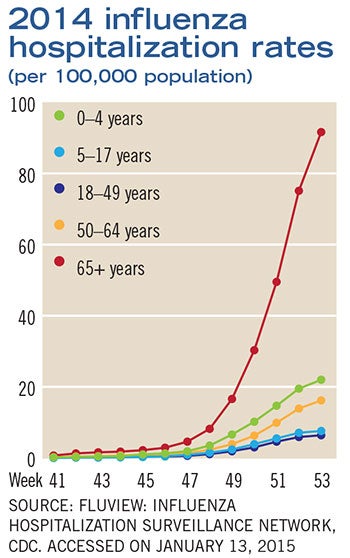CDC urges providers to use phone triage for early flu treatment
 |
| The age group 65 and older is far and away the one most affected by the current flu season. |
Health care providers may need to set up phone triage lines to facilitate the early treatment of high-risk influenza patients to cut down on hospitalizations related to the illness, says Tom Frieden, M.D., director of the Centers for Disease Control and Prevention (CDC).
Establishing triage lines would enable clinicians to discuss patient symptoms and start antiviral medication sooner, Frieden said during a conference call Jan. 9 to update the media on the 2014–15 flu season.
Frieden emphasized the importance of high-risk and severely ill persons with flu symptoms taking antiviral medication to begin early treatment of the flu and to be able to do so without an outpatient visit if possible. Antiviral drugs ideally should be administered to patients within the first two days of contracting the virus, he explained.
“Antiviral treatment can mean the difference between a milder illness and a stay in the hospital or intensive care unit or even death,” he said.
The CDC is working extensively in different areas of the country on new ways to treat patients more quickly, he said. Frieden did not elaborate on the proposal but said the CDC would release more information as it became available in the weeks following the Jan. 9 call.
Frieden said the nation was about halfway through the flu season, which typically lasts about 13 weeks. He characterized this season as a difficult one, especially for those 65 and older and for those with underlying medical conditions.
“That’s what we expect for a season where H3N2 is the predominant strain. H3N2 is a nastier flu virus than the other flu viruses and years that have H3N2 predominance tend to have more hospitalizations and, sadly, more deaths,” he said.
For those 65 and older, hospitalization rates were rising sharply last month. While the hospitalization rate was 52 per 100,000 in the week prior to the conference call, it had risen to 92 per 100,000 a week later.
Frieden projected hospitalization rates for that age group could reach as high as 183 per 100,000 by the end of the flu season, similar to the 2012–13 season when H3N2 was the predominant virus. The next highest hospitalization rate this flu season is children up to 4 years old who were hospitalized at a rate of 16.5 per 100,000 as of Jan. 9.
In terms of the overall number of flu cases, studies suggest that anywhere from 5 to 15 percent of the entire country gets flu in an average flu year, Frieden said. That means tens of millions of influenza cases occur annually, resulting in hundreds of thousands of hospitalizations per year, he said.
Because about two-thirds of H3N2 viruses analyzed this season are different from the H3N2 virus that’s included in this year’s flu vaccine, protection with vaccination against these drifted, or different, H3N2 viruses probably will be reduced, according to the CDC.
During 2007–08, drifted H3N2 viruses circulated during the flu season. Vaccination effectiveness against H3N2 during that season was 43 percent, CDC officials said.




